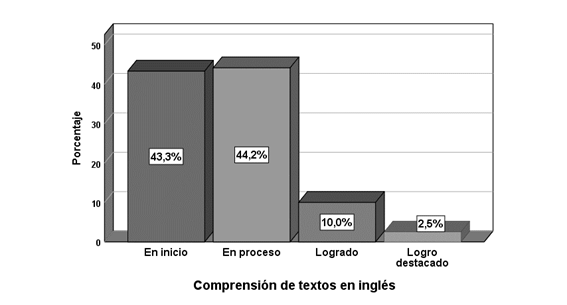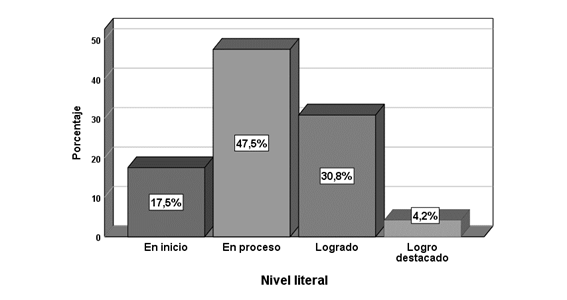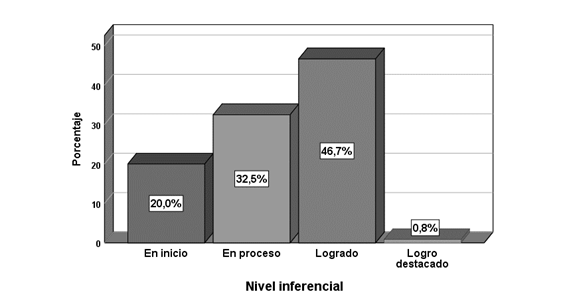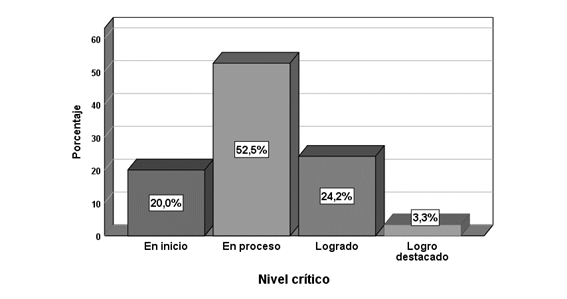Mi SciELO
Servicios Personalizados
Articulo
Indicadores
-
 Citado por SciELO
Citado por SciELO
Links relacionados
-
 Similares en
SciELO
Similares en
SciELO
Compartir
EduSol
versión On-line ISSN 1729-8091
EduSol vol.23 no.85 Guantánamo oct.-dic. 2023 Epub 05-Oct-2023
Original article
Comprehension of English texts in cadets of the Military School of Chorrillos "Coronel Francisco Bolognesi" in times of COVID 19
1Universidad César Vallejo Lima-Perú.
2Escuela Militar de Chorrillos “Coronel Francisco Bolognesi”. Lima-Perú.
3Miguel de Cervantes University, Chile.
The objective was to determine the level of comprehension of English texts in cadets of the military school of Chorrillos "Coronel Francisco Bolognesi" during COVID 19. This research is based on a quantitative approach, non-experimental and simple descriptive design. The population consisted of 1341 cadets of the five years of training and the sample was 120 cadets. A text comprehension test in English was applied, concluding that 44.2% of the cadets achieved a grade of level in process, due to the fact that in the educational institution priority is given to military instruction, however, it complies with the international standards required at the university level.
Key words: Reading comprehension; Critical reading; English instruction; Higher education
Introduction
Reviewing Andrade and Utria's (2021) treaties, one of the fundamental needs today is to develop text comprehension skills in foreign languages, especially in English, accepted as a lingua franca, so that people can communicate, carry out projects, collect data and establish contacts around the world. Since it is impossible to be an active participant in global life without a command of English, this language is not considered a foreign language to learn, but an important qualification that everyone should obtain.
According to Guadalupe et al. (2018), English is the second most common language used worldwide. However, teaching it is difficult due to the fact that acquiring it is not a process that occurs by itself, but involves the use of appropriate strategies in the learning processes. Therefore, it is essential that the educator receives adequate training to facilitate effective and meaningful learning of English. In this sense, the absence of methods that can improve text comprehension is recognized as one of the difficulties that exist in the area of language teaching.
And although the State has made efforts to improve the educational level in the teaching of English, the results have not been favorable. In this regard, a study by Education First (2020) indicated that Peru is ranked 58th out of 100 countries that understand the English language and the average student can only perform basic activities in this language, such as maintaining a simple conservation or writing an email. And these deficiencies in English proficiency have increased during the pandemic, due to the fact that in the development of virtual classes, students are not very participative.
Regarding the text comprehension variable, from another perspective Smith et al. (2021), is based on the cognitive load theory that suggests that teachers' teaching is more effective when they provide explicit guidance accompanied by practice and feedback, rather than when they require students to discover by themselves many aspects of what they should learn. In that sense, the process of reading involves acquiring new knowledge by extracting and constructing meaning from a text. That is, reading means understanding the text. Moreover, in the case of English language learners, vocabulary and grammar are preliminary learning requirements for effective reading and communication in English.
Similarly, text comprehension is described by Cisterna-Zenteno et al. (2016) as the linguistic ability to understand implicit and explicit messages from diverse texts in formal and informal registers in a communication environment, whether at a higher or professional level such as work. To do so, it must adhere to criteria linked to the objectives and methods to achieve the evaluation required through an instrument that corresponds to an international test of procedures and curriculum according to the student's interests. In this sense, in foreign language learning, reading comprehension implies the social practice characterized by the dialogic relationship between the reader and the text or written discourse.
Vargas-Chacón et al. (2021), for their part, highlight three critical axes to promote reading comprehension: the first is oriented to the topics planned for class sessions, allowing the teacher to master pedagogical techniques and virtual tools for interesting forums or debates; the second, the student will seek to achieve metacognition through interaction, which is the knowledge of each person about their cognitive processes; and the third, the educational, that which provides the infrastructure, equipment and appropriate conditions for the development of various activities aimed at meaningful learning.
Consequently, according to Tamayo et al. (2020), the difficulty lies in decoding the message presented to the reader through the text. Therefore, reading comprehension depends not only on the reader's level of accessibility to the text based on his or her knowledge of the subject matter, but also on the reader's ability to understand the language in which the text is found. This also involves processes of constructing the mental representation of the text, as a result of an interrelation between knowledge sources and cognitive processes. Readers must know the meaning of words, morphology and syntactic structures in order to understand the text.
For Dardjito (2019), constructing one's own interpretations of what one reads in English is an essential step in the reading process in that language, given that, from his or her prior knowledge, the reader elaborates new meanings when interacting with the text. This process unfolds differently for each reader due to the fact that each individual develops his or her own unique schemas and makes use of his or her own skills and abilities when presented with a text. Thus, the process involves the reconstruction of each individual's past experiences and culture, which ultimately leads to the establishment of personal identity.
Likewise, Gordillo and Flores (2009) indicate that text comprehension comprises the following levels: literal, inferential and critical. Regarding the literal level, for Andrade and Utria (2021), it corresponds to the amount of explicit information that a reader can retain when reading, such as characters, situations, places, events, among other things. For the case of the inferential level, Fajri (2019), points out that readers scrutinize a text with the purpose of finding relationships and associations of meanings that can help them read between the lines, make assumptions to deduce the implicit and thus perform the formulation of hypotheses, establishing conclusions afterwards. And at the critical level, Dardjito (2019) indicates that the reader can interpret and reflect to then make a judgment about the content of the text he or she has read. Critical reading is characterized by being evaluative, given that the reader's intervention is based on his or her criteria, training and knowledge of what he or she has read.
Based on the above, the general objective was to determine the level of comprehension of English texts in university students based on three dimensions in the literal, inferential and critical levels of comprehension of English texts.
Development
In accordance with the approach developed, the study was a quantitative research because the statistical analysis was performed. Likewise, the research was basic because it involved the use of knowledge and theories to know the level of text comprehension and its dimensions. As for the design, it was non-experimental because no manipulation of the variable was performed and it was limited to observing the phenomenon in its natural environment, collecting and describing the information on the variable to be investigated, thus being at a descriptive level. And the cut was transversal given that the data were collected in a single interval in time, which allowed the researchers to characterize and analyze the variable at the moment in which the events occurred.
On the other hand, the population consisted of 1341 cadets of the "Coronel Francisco Bolognesi" Military School of Chorrillos and the sample consisted of 120 cadets, the sampling being non-probabilistic and intentional (see Table 1).
In addition, the inclusion criterion was that the students were aspiring cadets, from the I, II, III and IV year of military instruction who are taking online English classes through the educational platform of the Language Center of the University of the Pacific (CIDUP).
Cadets who have been discharged, absent due to scholarship abroad or hospitalized due to illness were excluded. Ninety-five percent of the students are male and 100% are full-time students because it is a military training center.
As for the technique, evaluation was used, through the use of the reading comprehension test instrument.
This test consisted of 4 narrative texts in English, which were evaluated by 20 dichotomous scale questions (incorrect = 0, correct = 1), linked to the literal, inferential and critical levels according to (Flores, 2009).
It was administered online, using the Google Form tool for its design. Likewise, it was validated through the judgment of 3 experts and its reliability had a value of 0.65, having a high reliability.
In the case of data processing, the Excel program and the SPSS V.26 statistical software were used to perform the descriptive analysis of the text comprehension variable and its dimensions, by means of tables and graphs. For this purpose, after collecting the necessary data, the scales (Table 2) were established for the levels of measurement of the variable text comprehension in English, according to the score achieved by the students, which were: at the beginning [0-10], in process [11-13], expected achievement [14-17] and outstanding achievement [18-20].
After the application of the English text comprehension test to the cadets selected for the study, the data collected in the instrument were processed, obtaining the results shown below:
Figure 1 shows the levels of English text comprehension in cadets of the Chorrillos Military School and shows that 43.3% of the students achieved a beginning grade, 44.2% achieved a grade in process, 10% achieved a grade of expected achievement and only 2.5% achieved an outstanding achievement.
Interpreting Figure 2, in the case of the literal level of English text comprehension, 17.5% of the cadets achieved a beginning score, 47.5% achieved an in-process score, 30.8% achieved an expected achievement, and only 4.2% managed to obtain an outstanding achievement.
According to Figure 3, for the inferential level of English text comprehension, 20% of the cadets who took the test obtained a beginning score, 32.5% obtained an in-progress score, 46.7% obtained an expected achievement, and only 0.8% of the students had an outstanding score.
Regarding the results of Figure 4, in the critical level of English text comprehension, 20% of the students of the military institution achieved a score at the beginning, 52.5% obtained a score in process, 24.2% achieved an expected achievement and only 3.3% of the students who took the test achieved an outstanding score. Similarly, it was found that 44.2% of students achieved a grade in process.
The results are similar to what was found by Dardjito (2019), who, when exploring the correlation between metacognitive reading awareness and reading comprehension of English texts, found that the learners had low levels of reading proficiency, although their metacognitive reading awareness scores were high.
However, Tamayo et al. (2020) indicated that applying strategies that involve digital audiovisual materials, games and readings contribute to the improvement of the level of reading comprehension in students since they are more engaged and participative. In addition, Vargas-Chacón et al. (2021) sought to determine whether metacognitive strategies have an impact on reading comprehension in English, and found that they improve the students' reading comprehension level, since 56.7% reached an Achieved level and 70.0% were in Process.
On the other hand, both the literal dimension (47.5%) and the critical dimension (52.5%) are in process, while the inferential dimension is at the achieved level (46.7%). These results differ from those found by Andrade and Utria (2021), who, when characterizing the reading comprehension of university students, found that 82% of the students achieved better scores in the literal level and only 32% in the critical level.
While in the inferential level they were 52%, being close to the results obtained in the study. In that sense, Fajri (2019) when investigating on the strategies used by students to complete the TOEFL reading comprehension test, found that for 33% of the students, they had difficulties in the inferential level of text comprehension.
Thus, at the Chorrillos Military School, it has become evident that the results obtained in the English text comprehension test are at a level below the international standards required by higher education and the current Army Education and Doctrine directives, which provide that students must have mastered a second foreign language at the end of their studies.
Conclusions
In relation to the general objective, it is concluded that 44.2% of the students of the Military School of Chorrillos "Coronel Francisco Bolognesi", are in a level in process in the comprehension of texts in English, due to the fact that in the educational institution priority is given to military instruction, to the realization of military ceremonies and to the lack of organization on the part of the institution's directive, affecting the shortening of class schedules, making it difficult for the students to develop their academic activities normally.
In reference to the first dimension addressed, it is concluded that 47.5% of the cadets are in a level in process in the literal dimension of comprehension of texts in English, due to the programming of extracurricular activities and the lack of promotion of reading texts in English, finding that the students are confused when they read everything that is explicitly found in the texts, generally understanding the words in particular and in an isolated manner but when they wish to read the level of sentences or extensive texts, they hardly establish connections with the main idea.
In relation to the second dimension, it is concluded that 46.7% of the cadets are at an expected level of achievement in the inferential dimension of English text comprehension. In spite of this, the analysis of texts for the elaboration of research papers specific to their career is below the required standards, having problems at the moment of understanding from the indications of the information provided by the texts.
Finally, according to the third dimension, it is concluded that 52.5% of the cadets of the Military School of "Chorrillos "Coronel Francisco Bolognesi", are at a level in process within the critical dimension of comprehension of texts in English. As a consequence of the priority given to other military training activities, this deficiency should be considered as an Achilles heel in the Military School of Chorrillos "Coronel Francisco Bolognesi", since it leads cadets to have little ability to evaluate the English texts they read, limiting themselves to reading literally, without understanding the overall meaning of the texts and having difficulty understanding the author's intentions and, based on this, making their own judgments.
Referencias bibliográficas
Andrade, L. I. & Utria, L. E. (2021). Niveles de comprensión lectora en estudiantes universitarios. Palobra: Palabra Que Obra, 21(1), 80-95. https://doi.org/10.32997/2346-2884-vol.21-num.1-2021-3488 [ Links ]
Cisterna-Zenteno, C., Soto-Hernández, V. & Díaz-Larenas, C. (2016). Medición de habilidades de comprensión lectora y auditiva en estudiantes de Pedagogía en Inglés de una universidad chilena. Revista Electrónica Educare, 20(1), 1-21. https://doi.org/10.15359/ree.20-1.8 [ Links ]
Dardjito, H. (2019). Students’ metacognitive reading awareness and academic English reading comprehension in EFL context. International Journal of Instruction, 12(4), 611-624. https://doi.org/10.29333/iji.2019.12439a [ Links ]
Education First. (2020). Índice de Dominio en Inglés. https://www.ef.com.pe/EPI/ [ Links ]
Fajri, D. R. (2019). An Analysis of Student Strategy in Completing Toefl Reading Comprehension Test. Journal of English Language Teaching and Literature (JELTL), 2(2), 84-91. https://doi.org/10.47080/jeltl.v2i2.598 [ Links ]
Gordillo, A.; & Flores, M. del P. (2009). Los niveles de comprensión lectora: hacia una enunciación investigativa y reflexiva para mejorar la comprensión lectora en estudiantes universitarios. Actualidades Pedagógicas, 1(53), 95-107. https://ciencia.lasalle.edu.co/cgi/viewcontent.cgi?article=1100&context=ap [ Links ]
Guadalupe, C.; León, J.; Rodríguez, J. S.; & Vargas, S. (2018). Estado de la educación en el Perú. Análisis y perspectivas de la educación básica. GRADE. https://doi.org/10.15381/rsoc.v0i27.18979 [ Links ]
Smith, R.; Snow, P.; Serry, T. & Hammond, L. (2021). The Role of Background Knowledge in Reading Comprehension: A Critical Review. Reading Psychology, 42(3), 214-240. https://doi.org/10.1080/02702711.2021.1888348 [ Links ]
Tamayo, E. A.; Páez, J.; & Palacios, J. J. (2020). Influencia de estrategias de aprendizaje con herramientas TIC en la competencia de la comprensión lectora en inglés. Espacios, 41(26), 20. https://www.revistaespacios.com/a20v41n26/20412618.html [ Links ]
Vargas-Chacón, S. M.; Verde-Cena, A. E.; Berru-Vargas, I. del S.; & Zacarías-Nomura, C. A. (2021). Estrategias metacognitivas para mejorar la Comprensión lectora en inglés. Polo Del Conocimiento, 6(8), 154-176. https://doi.org/10.23857/pc.v6i8 [ Links ]
Received: April 12, 2023; Revised: May 10, 2023; Accepted: July 18, 2023











 texto en
texto en 








